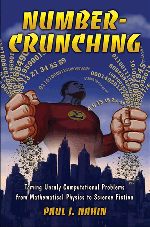Number-CrunchingTaming Unruly Computational Problems from Mathematical Physics to Science Fictionby Paul J. Nahin |

|
In the preface to his previous book Mrs. Perkins's Electric Quilt author Paul Nahin has advised:
If you think, as I recently heard a TV commentator claim, that you'll save gas by driving as fast as possible because you'll get where you are going sooner, then there is simply no hope for you as an analyst, and you shouldn't buy this book - save the money for the extra gas you'll use!
This advice applies to the book under review which is to a great extent is a continuation of the previous one, with one marked difference.
Concerning the technical side of the books, both deal with mathematics applied to solving physical problems. Nahin includes analysis and calculations that are often skipped over; the level of details reached usually exceeds that of most other books intended for a more or less general audience. This may be a boon for a curious student beginning to study calculus, but may prove a distraction for students on a more advanced level. The latter, however, won't have difficulty skipping some of the calculations.
The great value of both books stems from the informal manner of the narrative adopted by the author. Nahin is a marvelous story-teller; the number of stories he chose to share is remarkable; the stories themselves are tremendously entertaining.
Here's a small sample of discussions from the Number-Crunching book:
- The shortest path between two points in a plane
- Pythagorean Guess
- Physics Minus Mathematics: The Week of Creation
- The leapfrog problem - who is right?
Nahin shares anecdotes from his personal experience as a student and as a researcher, and also from published sources. The depth of his erudition is nothing short of astounding.
We learn of R. Feynman's probabilistic approach to solving Fermat's Last Theorem, Augustus De Morgan's challenge to his students to manually calculate roots of a third degree equation to 100 digits, the Monte-Carlo technique, the Fermi-Pasta-Ulam experiment, Newton's two-body solution and Euler's approach to the three-body problem, H. Poincaré's discovery of chaos after submitting a flawed paper to the King Oscar II competition ... - and this is just a very incomplete description of the book's contents.
Unlike the Mrs. Perkins's book, the Number-Crunching includes - in addition to real physical problems, detailed mathematical solutions (whenever feasible), and charming narrative - short computer simulations executed in MATLAB. Those of the readers who have experience with, say, Mathematica, but have no access to MATLAB, should not have a problem to recreate the MATLAB programs. In at least one case (Chapter 7) Nahin does not have an analytic solution and his exposition relies entirely on the computer simulation.
The books makes a brain stimulating read. I recommend it to all mathematically minded people with interest in physics; to physically minded people striving to learn how mathematics is applied to physical problems; and to a more general audience that will enjoy a delightful math/physics exposition.
Number-Crunching: Taming Unruly Computational Problems from Mathematical Physics to Science Fiction, by Paul J. Nahin. Princeton University Press, 2011. Hardcover, 400 pp, $29.95 ($18.97 at amazon.com). ISBN 0691144257.
|Up| |Contact| |Front page| |Contents|
Copyright © 1996-2018 Alexander Bogomolny73584037
